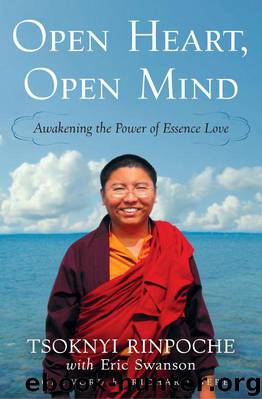Open Heart, Open Mind: Awakening the Power of Essence Love by Tsoknyi Rinpoche & Eric Swanson

Author:Tsoknyi Rinpoche & Eric Swanson [Rinpoche, Tsoknyi]
Language: eng
Format: azw3
ISBN: 9780307888228
Publisher: Random House, Inc.
Published: 2012-04-03T03:00:00+00:00
THE MIND AND CONSCIOUSNESS
In the Buddhist tradition there are actually eight different types of consciousness. Sounds like a lot, I know. We tend to think in a rather vague and uncertain way. But Buddhist masters of the past, like scientists of contemporary times, were determined to understand how we perceive and respond to the world around us, as well as to experiences we undergo internally. After lengthy investigation and debate they determined eight pathways or types of consciousness through which we receive, process, and interpret experience.
The first five are known as the sensory consciousnesses. In modern terms, we’d probably just refer to them as the senses: sight, smell, hearing, taste, and touch. But the Buddhist masters, like contemporary scientists, sought to emphasize the process through which different sense organs recognized, distinguished, and relayed messages about their experiences to higher levels of awareness and interpretation. Each of the five sensory consciousnesses, in its particular way, is aware that something is going on. The eyes are “conscious” of what they see when they become aware of seeing something, the ears are “conscious” of what they hear when they become aware of hearing something, and so on.
Each of these sensory consciousnesses sends messages “higher up”—and that’s where things get interesting.
The messages sent by the five sensory consciousnesses are received by what is known as a sixth consciousness—not to be confused with a “sixth sense.” It’s easier to think of the sixth consciousness as a receiver of information, rather like a telephone operator. It doesn’t judge or interpret the messages passed on to it. Its function is mainly to tell the conscious mind that something is happening: “Hey, a smell is going on here.” “Hey, a sound is going on here.”
Interpreting that smell, that sound, and so on as good or bad, pleasant or unpleasant, and so on, is—as I was taught—the function of the seventh consciousness, which is in many ways shaped by social, cultural, and personal influences, in a similar fashion to the ways in which we modify computer programs and adopt or reject options available on social networking sites.
The eighth consciousness is a kind of storehouse of all the patterns and programs ever “installed” on our living systems, and a complete record of any and all modifications we’ve made under societal or personal pressure. The eighth consciousness stores every aspect of all of our experience—every idea, every emotional pattern, every sense memory—kind of like the hard drive on a computer.
Download
This site does not store any files on its server. We only index and link to content provided by other sites. Please contact the content providers to delete copyright contents if any and email us, we'll remove relevant links or contents immediately.
The Way of Zen by Alan W. Watts(6557)
Ego Is the Enemy by Ryan Holiday(5350)
The Art of Happiness by The Dalai Lama(4097)
The Book of Joy by Dalai Lama(3947)
Why Buddhism is True by Robert Wright(3425)
Spark Joy by Marie Kondo(3274)
Shift into Freedom by Loch Kelly(3168)
Happiness by Matthieu Ricard(3022)
A Monk's Guide to a Clean House and Mind by Shoukei Matsumoto(2892)
The Lost Art of Good Conversation by Sakyong Mipham(2630)
The Meaning of the Library by unknow(2537)
The Unfettered Mind: Writings from a Zen Master to a Master Swordsman by Takuan Soho(2274)
The Third Eye by T. Lobsang Rampa(2245)
Anthology by T J(2185)
Red Shambhala by Andrei Znamenski(2168)
The Diamond Cutter by Geshe Michael Roach(2041)
Thoughts Without A Thinker: Psychotherapy from a Buddhist Perspective by Epstein Mark(1990)
Twilight of Idols and Anti-Christ by Friedrich Nietzsche(1875)
Advice Not Given by Mark Epstein(1862)
